Christian Choi: Convergent Design
Posted on March 30, 2016For this Emmy-nominated designer, lighting is as inextricably woven into scenic elements as lyrics are to music in a song or one dancer is to another in choreography. As seen through the perspective of Choi’s creative vision, without scenic elements what is there to light on a stage or a set? Conversely when you take away lighting, even the most glittering scenic element can quickly become ordinary.
The convergence of lighting and scenic design is at the heart of Choi’s work. After cutting his teeth as a lighting programmer and lighting director, working for Michael Jackson, Gloria Estefan, Mariah Carey and Cher (his work on her HBO special earned him a Prime Time Emmy nomination for lighting direction), he branched out into serious scenic design. Developing his own large scale 3-axis CNC machines, he’s engineered and fabricated scenery for TV studios.
Today, Choi’s passion for lighting and scenic design feed off one another. This much is very evident to anyone who’s watched Asia Entertainment’s Asia 70 and other broadcast and theatrical productions where he is both the lighting and scenic director. Speaking to us from the offices of his company, Emergent Entertainment Group, Choi, who has done digital screen and visual designs for the Latin Grammys and Super Bowl halftime shows, discussed the convergence of lighting and scenic design.
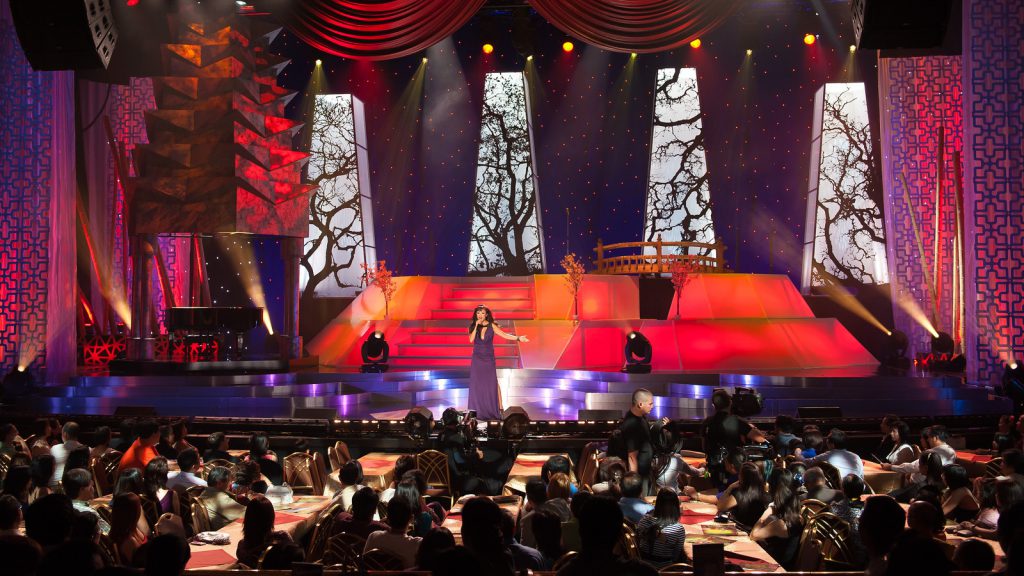
It’s widely acknowledged that there’s been a convergence between lighting design and scenic designs, but you have taken this union a step further as a fabricator in the sense that you actually make scenic elements. How did this happen?
“I reckon I’m a masochist to some degree. All in the name of art! Some of the smaller events that I do, such as news and talk show studios, don’t have huge budgets, and I’ve wanted to do things that require considerable CNC machining time. I enjoyed working on complex 3D carvings. I was relying on CNC a fair bit for the end result, so one day I researched and decided to build a CNC, then build some of the pieces that I had been getting from others with it. This way, the machining time wouldn’t be so much of a limiting factor in my designs. Add to this, the welding of the interior framing, and paint of the final product – and suddenly I was fabricating. Granted, I do still get things fabricated for me if they’re beyond my capability — or I foresee any time crunch possibilities.”
Does actually creating scenic elements influence your work as a lighting designer?
“Yes, absolutely. If in the end, I take nothing away from getting involved in scenic, at the very least it has made me acutely aware of how to better light a set. As a lighting designer, you devote attention to the scenic elements and so forth, but when you make the set, you really gain an OCD level of attention to detail.”
What advice do you have for lighting designers that are not as well versed in fabric as you? Are there certain types of fabrics that work best with lighting?
“Soft goods are certainly an integral aspect of a design and some work better than others. I enjoy using Tendo or Spandex in stretchy shapes with aluminum framing quite a lot. You can create huge filler pieces such as headers and so forth with Spandex on a budget. Also, reflective soft goods such as Mylar can be interesting to work with. Kabuki style drops, different draping styles, all are a huge part of a stage design. I also enjoy elegant drapery work, There aren’t a lot of resources on how to drape, so much of it is just learning from people, as well as trial and error.”
Can you give us an idea of how these the roles of lighting designer and fabricator interact with each other in your creative process?
“When designing a set, there are a number of things I try to keep in mind. How it will light is always at the top of the list. I’m usually thinking of finding opportunities to light the piece from inside. Examples are windows, channels, and insets where I can hide LED tape or LED fixtures. So many ideas lately are woven around LED, and LED tape as accents for the set. I usually design using materials that will best refract or reflect light. Most of the time I start off with a form, then design the lighting details later, so yes, for the most part, interior scenic lighting is the magical aspect of the set design that brings it to life.”
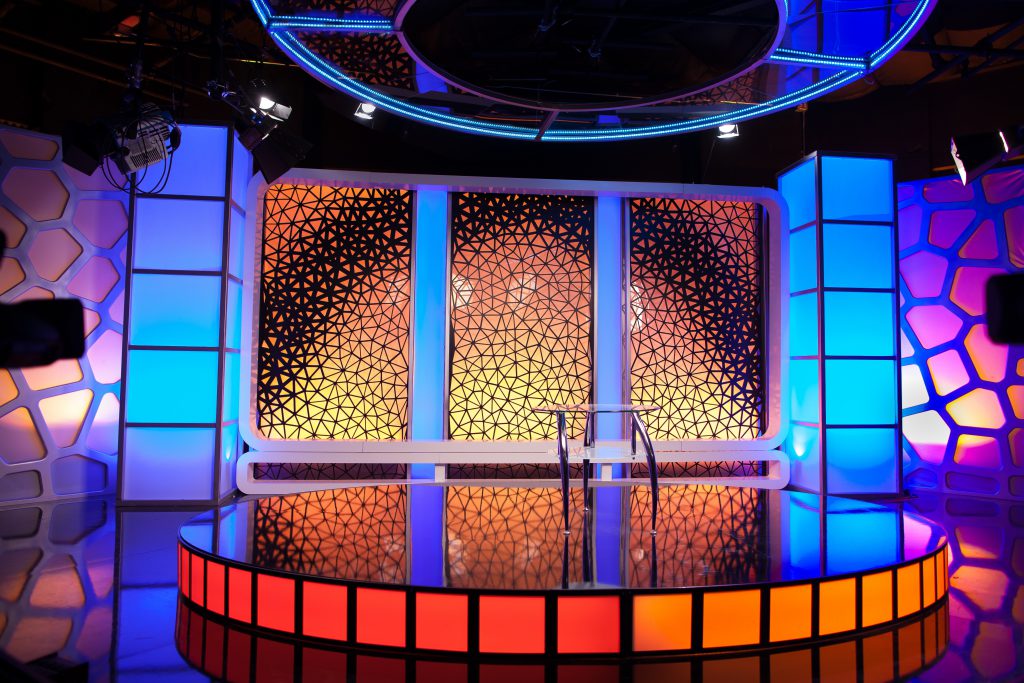
Your work is very elaborate, but at the same time (as in Asia 70) there seems to be an underlying simplicity – or maybe we should say intimacy – to it. How do you achieve this balance?
“That’s a good question. I strive to balance out any complexity in my design with elegance. Ultimately it’s the simplicity that is driving the design. There is nothing worse in design than a set or lighting design that looks too over-complicated, disconnected, and without intention. The complexity only acts as adornment to the flowing elegance of the broad strokes in the design. It can be quite easy to start a design around the complex textures and features, and just end up with a bunch of disjointed mishmash of complex figures. A good design IMHO is connective in nature and has a general shape that is only adorned with the texture of complexity, not the other way around. When designing, I often listen to Beethoven and try to structure the design similarly to how he structures his symphonies. I learned this from Frank Lloyd Wright. I saw a documentary on him and Beethoven was an emphatic influence in all his work. I tried it and it actually taught me a few things about structure.”
You mentioned Asia 70, your work in that project was very impressive, especially the varied ways in which you lit scenic elements; lighting some from the inside and reflecting light off others. How do you determine when to light from the inside and when to reflect? Do you have a preference between the two?
“Thank you for noticing that. I think interiorly lit pieces really pop well on camera, but to give a piece depth, it needs some reflectivity or it just looks like a glowing mass most of the time. So you have to balance the specular quality of the surfaces by carefully choosing your acrylics – or you have to do something like add opaque trim that will help to delineate the shapes.
“A piece can be both interiorly and exteriorly lit if it is treated right. Like anything, contrasts between reflection and refraction are a style to play with that can have profound implications on your overall design. The reflectivity of the floor, for instance, can bring to life all the interior lit pieces that are on top of it by doubling them in the reflection like a still pond.
“It makes everything come alive when you juxtapose interiorly lit pieces with reflective pieces, or accent interiorly lit surfaces with reflective surfaces in a design. By the same token, having areas of your design be flat painted can also be an interesting texture to mix in. Usually, I work with a base element then determine the interior lit parts of that base. Then I look at what is left over and decide what will be reflective, video, metallic, wood, or flat painted, or a combination of those elements. I design a lot with bevels, insets, and so forth, and love to also work with printing textures on clear acrylics and interiorly lighting them as well.”
Has the convergence of scenic and lighting design changed the way you evaluate lighting fixtures?
“Sure it has. Not just lighting fixture but video panels, strips as well. I love to embed video into scenic elements too. With lighting fixtures, I tend to look for LED products that will work in the space that I need. If I need a tall washer, I’ll go with something bright. If I need a fixture to work in a tight window, I’ll use LED tape or something along that line. I look for reliability in long term designs, such as news or talk show studios, and LED, for the most part, is reliable.”
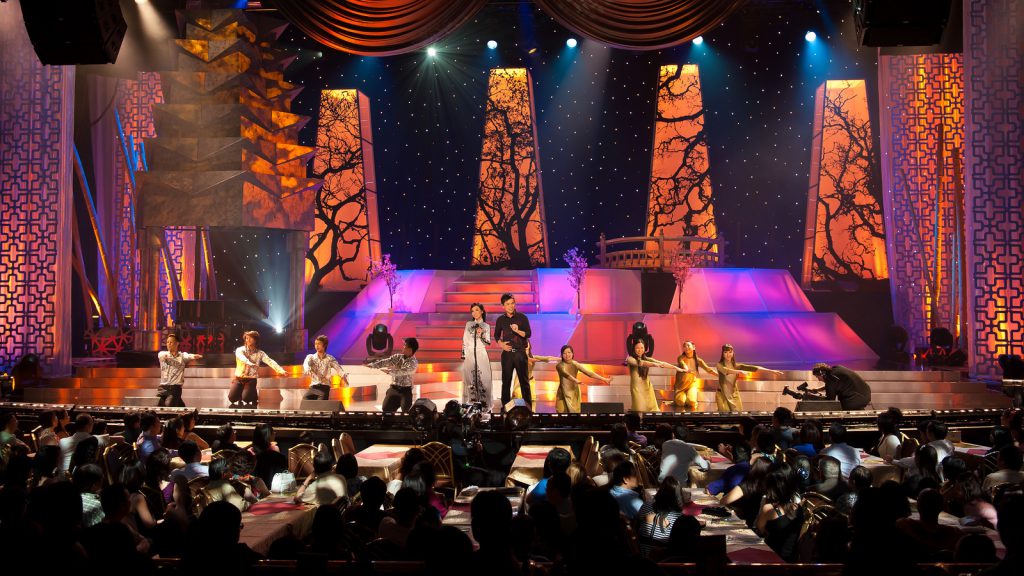
So how do you start designing? Do you begin by laying out your scenic elements? The lighting rig?
“I usually start with finding the center piece then working out from there. For instance, with a big show, I’ll start working with the center video elements first, then design around that. Or with a news or talk show, I’ll always start with the desk, or platform for the desk. The first thing I tend to put in a design is a 3D person for scale reference. Sometimes, I can’t quite see the centerpiece so I’ll start with anchoring elements such as columns or a cool floor design.
“Whatever I am inspired to work on at the time is what I work on, and since I know that the news desk usually inspires the backgrounds, I start with that. Sometimes creativity just points you in a direction, and you have to follow that direction while the creative instinct is hot. So I try to be a bit freer with my designs in that regard. Even if it is something that you think will not work, it’s good to follow your creative inner voice as you just might discover something new or cool that does work. It’s interesting because as a designer, you have to be open to new ideas and directions because sometimes you produce a rough diamond at first, but if you shape it and polish it right, it becomes a beautiful gem.”
What do you design in?
“I design scenic in a myriad of packages. One could write a whole article on this subject in itself. When you work with fabrication as well as design, you have to consider whether you want to draw things twice or just once. I’m usually drawing things at least once for render and presentation; then a second time for fabrication, and a third time for lighting design. Sometimes, I’ll work entirely in one package such as Rhino or Solidworks, others I’ll start a model in Modo or C4d, then bring it into Rhino, and pull nurbs surfaces or cutting paths off of the meshes for fabrication. “Generally, I work in Rhino, C4d, Modo and SW or SE for scenic, and then bring it into Vectorworks to light it. It’s very important when fabricating that you use a package that you can set finite dimension to whatever feature of a design you want to. It’s also important that you design a solid workflow for getting geometry out of the conceptual 3D and into your ECAD packages. This is probably the primary consideration when evaluating software: how can I get the geometry out of it, and into a package made for fabrication reliably?”
How do you get inspired? Long walks? Music?
“Music inspires me most, as does Pinterest. If I get too stuck, then some form of exercise can get my blood flowing again. I work out regularly, and I dance tango too at night time — at least a few times a week, so that helps.”
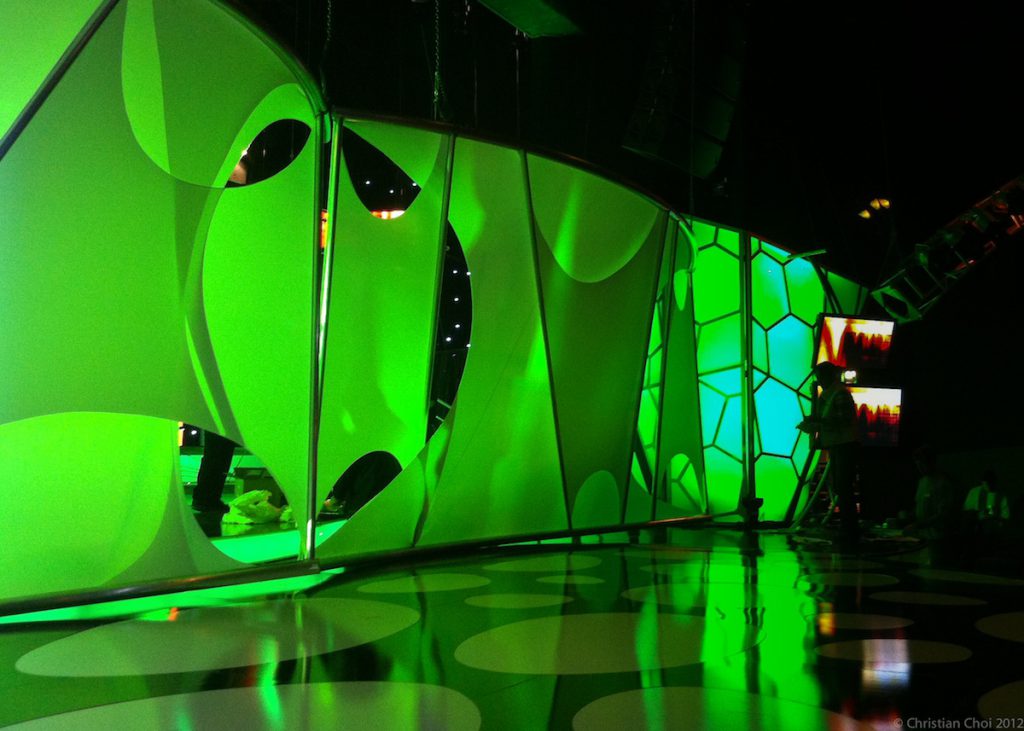
You’ve designed some beautiful broadcast sets. Among the things that strikes us about them is that they create a sense of movement, which no small accomplishment, considering that most people on a broadcast set aren’t moving. How do you do this?
“First off, I use video a lot in the sets so you inherently get a kinetic aspect with that. I also use algorithms that are found in nature to texture some of the hard scenic. For instance Voronoi, Delaunay, reaction diffusion, and Waire-phallen are all mathematical textures that can be generated across any surface in 3D. Then things are milled out to produce these very interesting textures. This is known more as High Def surfacing.”
Speaking of video, LED panels have come on strong in recent years. How does this impact the balance between scenic elements and lighting?
“I love using LED video in the set because it can augment it so much and change its look. Before getting into scenery, I was deep into media servers and video for several years, so it’s second nature to use video in the sets or lighting designs even if just for accents or a bit of kinetic visuals.
“I’ve noticed lately that quite a lot of productions are only using lighting and video panels, plus projections. That can be great, but it isn’t as effective as if, for instance, one creates a tangible screen surround for those panels. A screen surround won’t break the budget and can add so much. A bit of scenic always adds the elegance to a video set, whether it be a few steps in the background, some soft goods, or just a cool podium. The best advice I could give designers who are designing the set with all video elements is start using some soft goods to offset the video, or design a frame for some of the screens.”
From your perspective as a designer, what are the differences between projection and LED video?
“Lately, with the advancement of D3, there’s quite a lot more you can do with projection mapping onto curved and paneled scenic surfaces that makes for some very interesting results. LED panels are fantastic too because you don’t need the space you need to project, and it won’t matter if someone walks in front of the LED. LED is also quite a lot brighter, but can be pixelated in a close-up background if it is too high of a pitch. Pixilation can be a good thing too, and low res stuff definitely has a place for pixel mapped sets. I enjoy mixing projection mapping with LED pixel mapping. LEDs can be quite a bit more practical to use than projection in certain instances, but it just depends on what you are doing. You can get very creative with both technologies.”
Earlier in your career you worked for Michael Jackson History World Tour. Can you tell us what you did and how that impacted your development?
“I was just a kid when that happened, and it was fantastic because I became very familiar with how touring worked back then, and I managed to see the world, and get paid for doing it, which was brilliant. It helped to have that as a credit, and working as a programmer for Peter Morse was no shabby gig, but in the long term, apart from helping my CV, I probably wasn’t mature enough for it to have much of an impact on my design sense. I was only 25. Back then I was a moving light maniac, and had very little clue about all the other aspects of a full production design.”
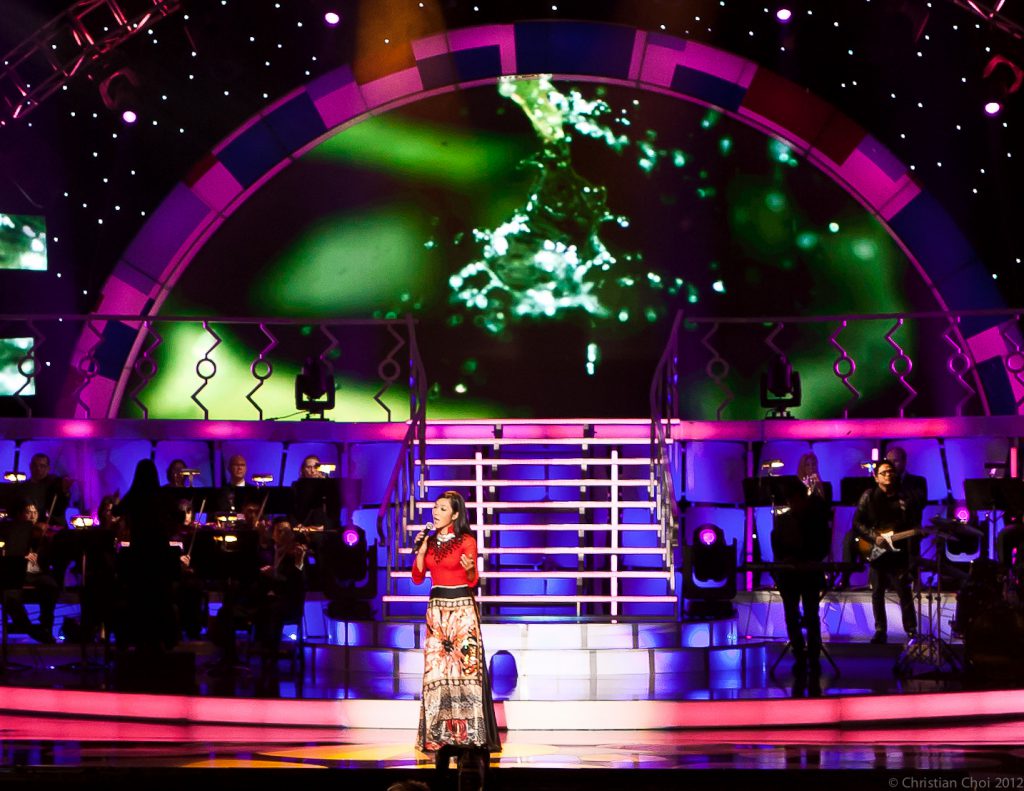
Who were the big influencers in your career?
“Allen Branton was a huge influence on my lighting and even scenic. Allen could’ve probably been a scenic designer, or even a video director. That guy has some seriously deep knowledge of production and what should sensibly be there, or not there. Working with Peter Morse was great too, he has such a dedication to the client and end result, and knows what looks good. Luc Lafortune for not forgetting the sensitive nature of lighting a scene and connecting with an audience. I loved lighting Marc Fischer and Ray Winkler sets back in the day. Every Marc Fischer show was totally phenomenal and exciting show to work on.”
What do you regard as your career highlights?
“The Primetime Emmy nomination was one. It’s not every day that happens, if not once in a lifetime. It would be nice to win one, but I’m content with having even been considered. Also working with some of the biggest designers in the business was fantastic too. I’d say working on two Super Bowl halftime shows, working with Madonna’s, Britney Spears, N’Sync, Marc Anthony, Robin Williams, and John Leguizamo HBO specials were a nice highlight and the JLO, Dixie Chicks, Aerosmith Icon, and Metallica Icon shoots were also great.”
What is the most essential tool in your lighting toolbox?
“So you’re asking that if I could use only one type of lighting fixture what would it be?”
Yes that’s a good way of putting it?
“Probably a video panel. If I was forced to only have one figure it would probably be a framing profile with gobos and variable edge and the spotlight controller for it.”
You’ve designed all over the world. Are the demands of design different in different places?
“Not so much the design side as the logistics side. Malnourished stagehands, military and religious police, weather can all present added challenges. Some cultures are against certain colors like red, some are all for red, but that is just customary stuff that you get used to. It can be more challenging to get certain items in certain countries than in the US, and this affects budget because of shipping.”
How would you like to be remembered as a designer?
“I suppose in a positive light, having helped others in some way would be good enough. As a designer, I’d like to be remembered as the one who wasn’t afraid to take chances and try new tech out in a show. The beta software user!”